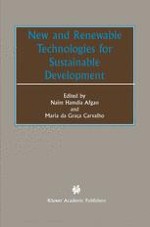2002 | OriginalPaper | Buchkapitel
Combustion of Sawdust
verfasst von : Maarit Talvitie, Sanna Sierilä, Antti Oksanen, Markku Miettinen
Erschienen in: New and Renewable Technologies for Sustainable Development
Verlag: Springer US
Enthalten in: Professional Book Archive
Aktivieren Sie unsere intelligente Suche, um passende Fachinhalte oder Patente zu finden.
Wählen Sie Textabschnitte aus um mit Künstlicher Intelligenz passenden Patente zu finden. powered by
Markieren Sie Textabschnitte, um KI-gestützt weitere passende Inhalte zu finden. powered by
In Finland new drying and combustion devices that enable the use of sawdust or wood pellets instead of oil in municipal scale power boilers with only slight changes to the boiler have been developed. The two plants in operation in Finland at the moment using the new CMR-burner for biomass produce district heat with thermal powers of 1 and 2.5 MW, respectively.In this study the combustion of sawdust in the above-mentioned device is investigated by modelling a 3D case with a commercial software. The code includes a group of special subprograms, including one for the pyrolysis of particles and for their trajectories. Still, for several features such as the prediction of the reaction rates as well as the particle source terms appropriate submodels have to be coded and implemented to the program.The combustion takes place in two stages, i.e. primary air is fed into the burner together with fuel while secondary air is fed into the after-burning zone further in the furnace. The size distribution of the sawdust particles is quite wide, ranging from around hundred micrometres to several millimetres. The moisture content of the fuel varies between 10 and 20%. Primary air and fuel are fed in with a very high swirl while secondary air has a considerably weaker swirl. The highly swirling flow field in the burner has a significant effect on the mixing process and on the particle trajectories. Thus, in addition to chemical reactions also the flow field has to be modelled as accurately as possible. In this case the RNG k-e model was chosen. The reaction rates for the pyrolysed phase are mainly calculated by the EDC reactor technique while for the nitric oxide formation the Arrhenius-type equation with mean values is used. The combustion of the pyrolysed fuel is modelled with the simple two-step mechanism.The subprograms include a number of different parameters mostly related to fuel properties some of which have to be evaluated due to lack of exact knowledge. In spite of this, the calculated results seem to be in quite a good agreement with the experimental data available.
